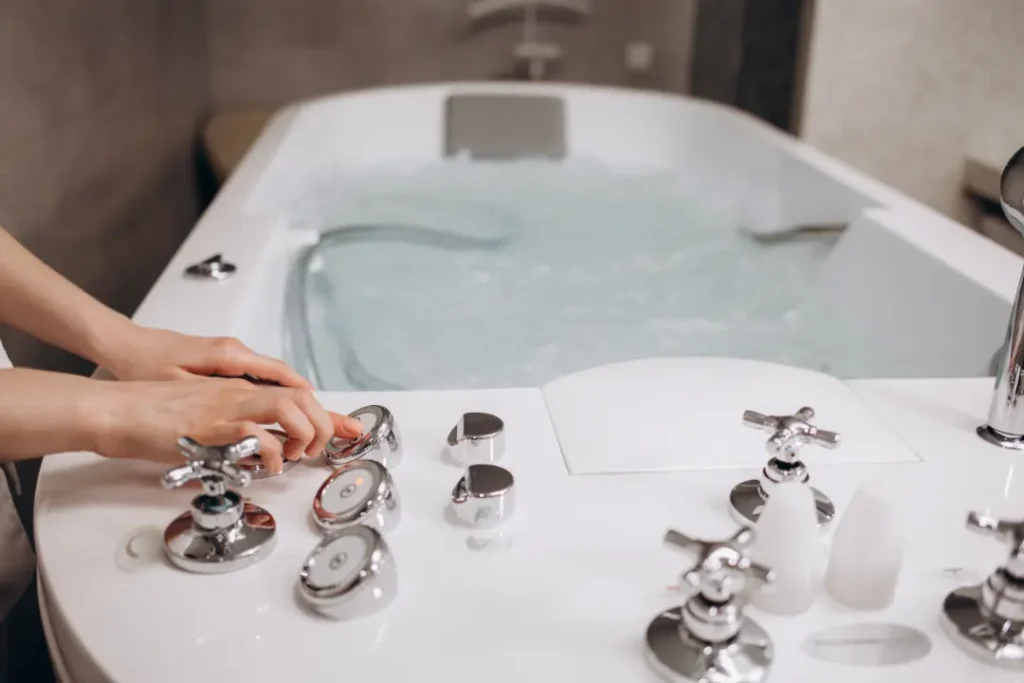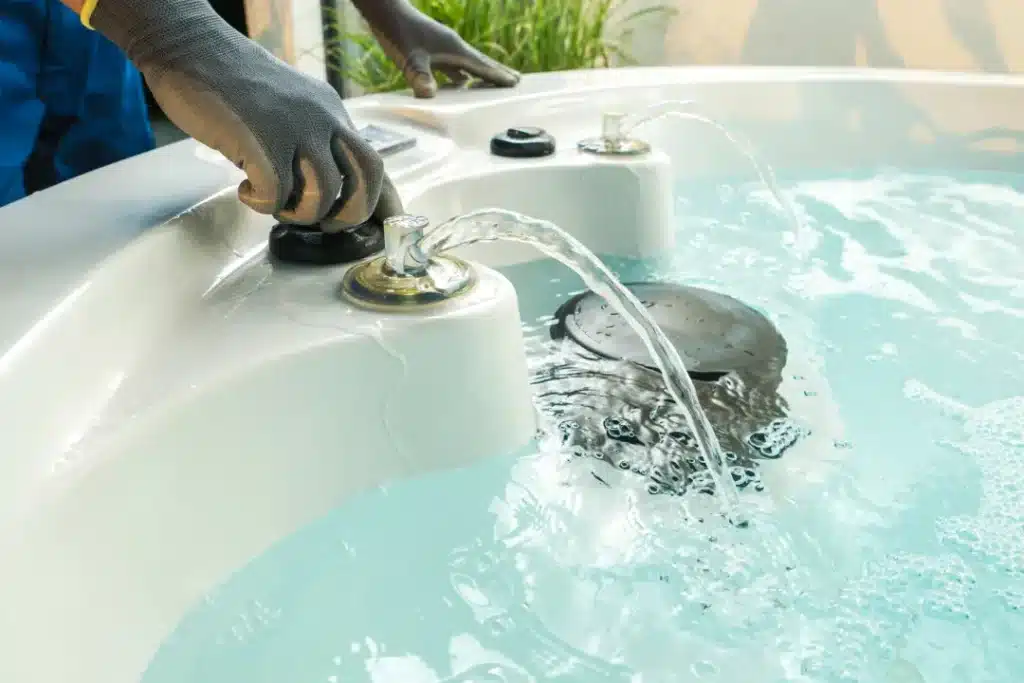Owning a saltwater hot tub offers a luxurious and gentle spa experience, but understanding the ongoing maintenance costs is key to keeping it running smoothly and looking great.
While saltwater hot tubs are often easier on the skin and require fewer harsh chemicals than traditional chlorine models, they still come with regular expenses like electricity, salt cartridges, water testing, and occasional repairs.
In this article, we’ll break down what you can expect to spend annually to maintain your saltwater hot tub, helping you budget wisely and enjoy your spa without surprises.
Whether you’re a new owner or considering a switch to saltwater, this guide will give you the essential insights you need.
Key Takeaways
- The average monthly maintenance cost for a saltwater hot tub ranges from $50 to $200 for professional services and $10 to $30 for DIY maintenance, with saltwater systems being generally more economical than traditional chlorine hot tubs.
- Key factors influencing maintenance costs include electricity costs, chemical requirements, and routine cleaning; investing in proper insulation and energy-efficient practices can further reduce expenses.
- Regular maintenance, whether professional or DIY, is critical for avoiding costly repairs and enhancing the longevity of saltwater hot tubs, with preventative practices being essential for effective upkeep.
Average Saltwater Hot Tub Maintenance Cost
When evaluating the maintenance cost of a saltwater hot tub, comparing professional services to DIY maintenance is important. On average, professional hot tub maintenance costs around $200 or more per month.
This cost typically includes water testing, chemical balancing, and regular cleaning. For those who prefer to take a hands-on approach, self-maintaining a hot tub can cost between $10 to $30 per month.
Saltwater hot tubs generally incur lower ongoing costs than traditional chlorine hot tubs, making them a more economical choice due to the reduced need for frequent chemical treatments, as saltwater systems naturally generate chlorine.
Moreover, saltwater hot tubs consume less electricity than a lightbulb, making them energy-efficient options for many households.
Considerations and maintenance tasks for hot tubs include:
- Higher hot tub water temperatures can increase energy consumption and may require more frequent chemical treatments, impacting overall costs.
- Frequent water testing ensures water safety and helps manage chemical expenses effectively.
- Regular tasks, such as draining and refilling the hot tub every 3 to 4 months, are essential for smooth operation.

Factors Influencing Saltwater Hot Tub Maintenance Costs
Several factors influence the cost of maintaining a saltwater hot tub. Each of these elements plays a crucial role in determining the overall cost of maintenance expenses, including unexpected costs and associated costs, and will be explored in detail in the following subsections.
Electricity Costs
Electricity costs are a major part of hot tub maintenance, including the electric bill and the final bill.
However, energy use can vary greatly depending on the model’s efficiency and insulation quality. Heater power, insulation, and efficiency all have a big impact on electricity costs.
The main reason hot tubs use a lot of electricity is due to heating and circulation. Improving the hot tub’s insulation can greatly reduce energy expenses, making it a smart investment over time.
Chemical Costs
Chemical costs are another important aspect of maintaining a saltwater hot tub.
One of the key benefits of saltwater hot tubs is that salt needs to be replaced infrequently, typically after changing the water or significant water loss. This results in minor cost implications compared to traditional chemicals.
Basic monthly water care costs using chemical additives are approximately $20, with annual costs ranging from $100 to $250+. However, the relatively low cost of saltwater hot tubs makes them worth considering.
Frequent water testing and regular testing maintain proper chemical balance, preventing excess chemical costs.
Routine Cleaning and Filter Replacement
Regular cleaning and filter maintenance ensure efficient operation and longevity of the hot tub. The initial cost for cleaning supplies ranges from $50 to $100.
Routine cleaning and filter replacement maintain optimal performance and can prevent costly repairs.
Long-Term Savings with Saltwater Systems
Investing in a saltwater hot tub can lead to significant long-term savings. Savings primarily stem from reduced chemical purchases and lower repair and replacement costs due to the gentler nature of saltwater on components.

Reduced Chemical Purchases
Transitioning to a saltwater system can lead to annual savings of $100 to $200 on chemical costs. The low levels of salt needed for operation result in negligible costs.
Overall, saltwater hot tubs provide a cost-effective alternative to traditional chemical-based systems by offering lower chemical costs.
Its self-sanitizing nature significantly cuts down on chemical purchases, thereby enhancing the overall experience.
Lower Repair and Replacement Costs
Salt water is known for its gentler nature, which impacts the longevity of hot tub components. Softer water reduces wear and tear, leading to fewer repairs, ultimately saving on maintenance and replacement costs.
Minimizing wear and tear helps hot tub owners save on costly repairs and prolongs the lifespan of their hot tubs. This makes saltwater hot tubs a wise investment for those looking for long-term savings.
Professional vs. DIY Maintenance
When it comes to maintaining a hot tub, owners often find themselves choosing between professional services and DIY maintenance.
Professional Maintenance Services
Professional hot tub maintenance usually consists of several key tasks. These include testing and balancing the water, cleaning filters and the water line, and conducting a multipoint inspection. Understanding the services included in maintenance packages is important before selecting a plan.
Professionals generally recommend servicing a hot tub every week for heavy use, while occasional use may require fewer visits. Some providers may offer discounts for customers who sign up for regular maintenance contracts. Requesting an itemized contract in writing before starting maintenance work is advised.
DIY Maintenance Tips
For those who prefer to maintain their hot tubs themselves, regular maintenance, including water balancing and filter cleaning, is essential for optimal performance. Hot tub filters should ideally be cleaned 1 to 2 times per month.
Mastering basic maintenance tasks can significantly reduce the reliance on professional services. These tasks include:
- Establishing a regular maintenance schedule
- Using a quality cover
- Monitoring sanitizer levels
- Taking a shower before use
- Investing in energy-efficient models
- Exploring alternative sanitizing methods.
Common Issues and Their Costs

Corrosion and Scaling
Saltwater can damage metal parts in hot tubs over time, creating a need for frequent maintenance and repairs. Corrosion, a significant issue in the salty environment, necessitates regular inspections and potential component replacements.
Addressing corrosion can increase maintenance costs due to necessary repairs and replacements over time. Regular management of scaling, caused by higher calcium levels, is also essential to prevent damage.
Sensor and Generator Malfunctions
One of the most common malfunctions in saltwater hot tubs is the failure of the salt cell. The cost range for salt cell replacements is typically $200 to $400 every 3-5 years.
Routine maintenance of saltwater systems helps in early issue detection and mitigates repair costs. Common malfunctions in saltwater systems often lead to significant repair costs if not addressed timely.
Why Trust Action Spa Repair for Your Saltwater Hot Tub Needs?
Our hot tub repair service in oceanside ca, we are dedicated to helping you get the most enjoyment and longevity from your saltwater hot tub. With over 30 years of hands-on experience serving Oceanside and the wider San Diego County community, we know exactly how to keep saltwater systems running efficiently and cost-effectively.
Our expert technicians are skilled in troubleshooting and repairing all brands and models of saltwater hot tubs, ensuring the water is always gentle on your skin and your system works flawlessly.
We make it easy to protect your investment by offering prompt service appointments, transparent communication, and honest advice on everything from routine upkeep to advanced repairs.
High customer satisfaction and a commitment to quality set us apart—just ask any of our many repeat clients.
When you want hassle-free saltwater hot tub maintenance or repairs, count on Action Spa Repair for the responsive, professional service you deserve. Contact us today to schedule your next service and experience why your neighbors trust us to keep their spas in top shape!
Tips for Reducing Saltwater Hot Tub Maintenance Costs
There are several strategies to reduce maintenance costs for saltwater hot tubs. Regular maintenance can extend the lifespan of hot tubs by preventing issues before they arise.
Showering before using the hot tub minimizes contaminants and helps keep maintenance costs lower.
To save money on hot tub costs:
- Choose a smaller model for 2-3 people to reduce initial and maintenance expenses, considering the hot tub’s size.
- Avoid luxury features and extras to keep costs low.
- Use a quality cover to minimize heat loss and keep debris out of the water, which reduces maintenance costs.
Energy-Efficient Practices
Using variable-speed pumps for your hot tub can reduce overall energy consumption as they adjust power based on demand, which can vary depending on usage patterns. Maintaining a consistent water temperature helps in reducing electricity consumption.
A hot tub cover helps keep heat in, enhancing energy efficiency. Setting timers for circulation pumps is recommended to minimize electricity costs.
Preventative Maintenance
Testing and balancing the water chemistry in a hot tub should be done 2 to 3 times per week to ensure proper maintenance.
A water testing kit is crucial for maintaining proper water chemistry in a saltwater hot tub.
Routine tasks like cleaning salt cells and balancing water chemistry can often be handled safely by the owner.
Frequently Asked Questions
How often should I drain and refill my saltwater hot tub?
To maintain water quality and ensure efficient operation, it is recommended to drain and refill your saltwater hot tub every 3 to 4 months.
What are the main differences in maintenance costs between saltwater and traditional chlorine hot tubs?
Saltwater hot tubs typically incur lower ongoing maintenance costs compared to traditional chlorine hot tubs, as they require fewer chemical purchases due to their ability to generate chlorine naturally. This results in significant savings over time.
Can I convert my existing hot tub to a saltwater system?
You can convert your existing hot tub to a saltwater system, which can be a cost-effective alternative to buying a new one. This conversion may save you significant amounts of money while enjoying the benefits of a saltwater system.
How can I reduce electricity costs for my saltwater hot tub?
Using a high-quality cover can significantly minimize heat loss and help reduce electricity costs for your saltwater hot tub. Additionally, maintaining a consistent water temperature and utilizing variable-speed pumps with timers for circulation will further enhance energy efficiency.
What are common issues with saltwater hot tubs and their associated repair costs?
Saltwater hot tubs commonly face issues such as corrosion, scaling, and sensor malfunctions, with repair costs typically ranging from $150 to $1,100, depending on the specific problem. Regular maintenance is essential to mitigate these problems and associated expenses.
Conclusion
Maintaining a saltwater hot tub involves a variety of costs, from monthly electricity and chemical expenses to occasional repair and replacement costs. However, the benefits, including lower long-term maintenance costs and a more enjoyable hot tub experience, often outweigh these expenses.
Saltwater systems reduce the need for frequent chemical purchases and lower the wear and tear on hot tub components, leading to fewer costly repairs over time.
By choosing the right maintenance strategy and implementing energy-efficient and preventative practices, hot tub owners can significantly reduce their maintenance costs.
